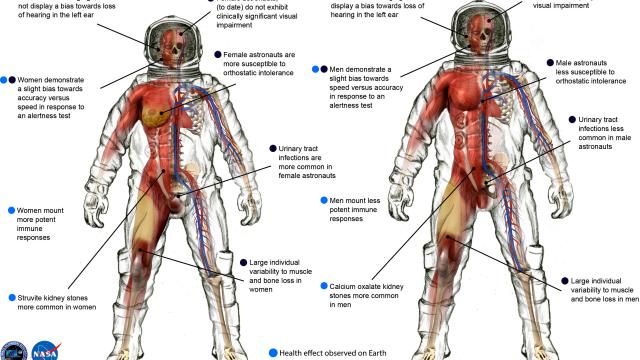NASA and the National Space Biomedical Research Institute have published a new research paper detailing how space flight affects “cardiovascular, immunological, sensorimotor, musculoskeletal, reproductive and behavioural implications” on men and women. Here are the highlights.
- Orthostatic Intolerance, or the inability to stand without fainting for protracted periods, is more prevalent upon landing in female astronauts than in their male counterparts. One possible reason for this observed difference in orthostatic intolerance between the sexes is reduced leg vascular compliance, which was demonstrated in bed-rest studies — which is a ground analogue for spaceflight.
- Women have greater loss of blood plasma volume than men during spaceflight, and women’s stress response characteristically includes a heart rate increase while men respond with an increase in vascular resistance. Still, these Earth observations require further study in space.
- The VIIP syndrome (visual impairment / intracranial pressure) manifests with anatomical ocular changes, ranging from mild to clinically significant, with a range of corresponding changes in visual function. Currently 82% of male astronauts vs. 62% of women astronauts (who have flown in space) are affected. However, all clinically significant cases so far have occurred in male astronauts.
- Changes in function and concentration of key constituents of the immune system related to spaceflight have been reported. However, differences between male and female immune responses have not been observed in space. On the ground, women mount a more potent immune response than men, which makes them more resistant to viral and bacterial infections; once infected, women mount an even more potent response. This response, however, makes women more susceptible to autoimmune diseases. It is not clear if these changes on the ground will occur during longer space missions, or missions that involve planetary exploration (exposure to gravity).
- Radiation presents a major hazard for space travel. It has been reported that female subjects are more susceptible to radiation-induced cancer than their male counterparts; hence radiation permissible exposure levels are lower for women than men astronauts.
- Upon transition to microgravity after arriving at the International Space Station (ISS), female astronauts reported a slightly higher incidence of space motion sickness (SMS) compared with men. Conversely, more men experience motion-sickness symptoms upon return to Earth. These data were however not statistically significant, due both to the relatively small sample sizes and small differences in the incidence of SMS reported by the men and women astronauts.
- Hearing sensitivity, when measured at several frequencies, declines with age much more rapidly in male astronauts than it does in female astronauts. No evidence suggests that the sex-based hearing differences in the astronaut population are related to microgravity exposure.
- The human musculoskeletal response to gravity unloading is highly variable among individuals and a sex-based difference was not observed.
- Urinary tract infections in space are more common in women and have been successfully treated with antibiotics.
- There is no evidence of sex differences in terms of behavioural or psychological responses to spaceflight. Analysis of ISS astronauts’ neurobehavioral performance and sleep measures showed no sex or gender differences using the Psychomotor Vigilance Test (PVT) of alertness and Visual Analogue Scales of workload, stress, and sleep quality. Since all all astronaut candidates undergo a robust process of psychological screening and selection, the likelihood of an adverse behavioural health condition or psychiatric disorder is greatly diminished.
Although there are a lot of differences, at the end one thing is clear: Both men and women are pretty much screwed up when it comes to long stays in microgravity. We evolved to walk on Earth, not to be weightless in space. You can read the paper here.
